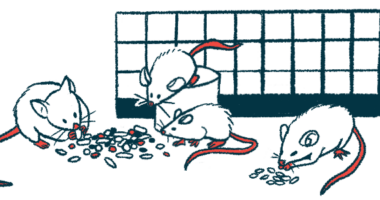Glycogen-measuring MRI shows promise in Pompe mouse model
GlycoNOE detects glycogen accumulation in mice, study shows

GlycoNOE, a non-invasive form of MRI, detected glycogen accumulation in the muscles of a Pompe disease mouse model, demonstrating its potential as a noninvasive tool to directly assess disease severity and treatment response in patients, according to a study.
The approach “holds great potential to facilitate pre-clinical and clinical studies on [Pompe],” the researchers wrote in the study, “Simultaneous monitoring of glycogen, creatine, and phosphocreatine in type II glycogen storage disease using saturation transfer MRI,” published in Magnetic Resonance in Medicine.
Pompe disease is a rare genetic condition marked by a deficiency in the activity of GAA, an enzyme that breaks down glycogen, a complex sugar molecule that serves as a form of energy storage. Without functional enzyme, glycogen builds to toxic levels inside cells, disrupting the function of different organs and tissues, especially the heart and other kinds of muscle.
Several methods have been used to assess Pompe’s severity, progression, and response to treatment, including creatine kinase blood tests, a measure of muscle damage; walking or lung function tests; and imaging tests to track muscle degeneration. Many of these assessments may not be specific to Pompe.
“The ability to non-invasively assess [Pompe] progression or treatment response would be valuable in the diagnosis and management of this life-long disease,” the researchers wrote.
Alternative approach
As an alternative approach, a team in the U.S. and China tested the utility of glycoNOE, a noninvasive MRI technique that detects glycogen in the body.
The researchers regularly scanned the skeletal muscles, or those attached to bones, of a Pompe mouse model (lacking GAA) from two weeks to 48 weeks of age, or almost a year. Healthy adult mice, aged three to six months, served as controls.
GlycoNOE signals were used to measure the levels of glycogen in muscles. MRI data also assessed several metabolites related to energy production, such as creatine, phosphocreatine, and taurine. Tissue levels of glycogen and the metabolites were measured as a comparison.
At 16 weeks, or about four months, Pompe mice showed substantially higher glycoNOE signals than controls. This was “attributed to glycogen accumulation in [Pompe] skeletal muscle,” the researchers wrote.
GlycoNOE signals were significantly higher in Pompe mice than in the control mice across all ages. At two weeks, glycoNOE signals in Pompe mice were 119% higher on average than controls. This rose to 311% by 12 weeks and continued to rise to over 400% by 48 weeks.
In line with these findings, tissue samples collected at 12 weeks showed mean glycogen levels were more than 15 times higher in the muscles of Pompe mice than in healthy mice (31 millimole/kg vs. 2 millimole/kg). In comparison, the glycoNOE signal difference between Pompe and control mice at 12 weeks was equivalent to a glycogen level difference of 29 millimole/kg.
MRI signals that paralleled phosphocreatine levels in Pompe mice decreased with age during the first 12 weeks, then became relatively stable at 34% lower than control mice.
At two weeks, Pompe mice’s total creatine signals were 37% higher than those of controls, and decreased to comparable levels by 12 weeks. Creatine relative to taurine signals followed a similar pattern. In line with MRI data, tissue tests at 12 weeks showed no differences in creatine and taurine levels between Pompe and control mice.
“GlycoNOE MRI could detect abnormal glycogen accumulation in skeletal muscle of early-stage [Pompe] mouse model, and successfully monitor the progression of [Pompe],” the researchers concluded. “At the same time, changes in [creatine] and [phosphocreatine] levels could also be monitored.”







